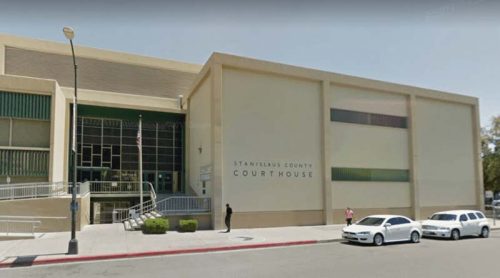

By Destiny Gurrola and Ramneet Singh
MODESTO, CA – Judge Shawn Bessey of Stanislaus County Superior Court this week denied a man’s petition to remove his murder conviction for his involvement in a gang-related 2010 home invasion that led to a murder.
The appearance was set for resentencing hearing under Penal Code section 1172.6. Everyone in the court referenced evidence and testimony from the trial from numerous sources.
The prosecution presented the events connected to the 2010 case, noting that on March 24, 2010, the accused and five other gang members attempted to break into a home around midnight, believing “they were doing a home invasion of a drug dealer who sold drugs to or with a rival gang.”
The accused was the driver and encountered other people pulling into the house, who were overpowered with “a show of armed force and violent intimidation” and were taken to the backyard.
One of the passengers was hit with a gun around this time, and the accused and another person broke into the house, where the accused allegedly “fired his weapon several times.”
Given the violence and sounds from inside, the group outside believed that the invasion did not go to plan, said the prosecutor, and when one of those being held tried to escape, he was shot dead.
The prosecutor noted the accused was “convicted of murder under the old felony murder rule. At issue for this hearing is whether (the accused) would still be convicted of murder under the revised codes.”
The prosecution argued he still would be guilty of murder because he was “a major participant who acted with reckless indifference,” noting, he was a major participant, and involved in the planning. She believed his duress argument at trial was not sufficient.
The prosecution continued, saying “they were all gang members, even (the accused) admitted that. He knew they were all his homeboys.” After they got weapons and put on specific clothing, the accused drove them to the murder scene, and although he didn’t supply the weapons, he did use the gun.
Prosecution moved on to discuss the other car in the driveway and that one of the passengers testified to being threatened. The prosecutor noted the violence at that point and the different members testified to a willingness to commit violence.
The DDA stated the accused was there for the whole crime and furthered the violence in the house, firing his gun twice, once when he assumed the person in the house was reaching for a weapon.
The prosecutor countered the defense argument that the accused did not know the victim in the backyard had been shot, maintaining the accused was present at the crime scene and elevated the violence, arguing “he knew that guns would be used in the robbery…every one of them was armed.”
The DA noted the accused’s history in the gang and how acting hostile in those situations was “part of the gang culture,” adding he was a part of the gang since he was 16, and almost 21 during the murder incident.
In defense of his client, private attorney John Hillenbrand argued “all of the behavior of (the accused) was in the context of an armed home invasion. It had nothing to do with the shooting of the person outside the house which was a separate incident.”
He explained that although the accused was present, he was not aware of the events, the murder that was taking place outside. Hillenbrand added, “There is no evidence of the use of a firearm by (the accused) that was in effect endangering human life.”
Hillenbrand acknowledges that the accused fired two shots with his gun at the scene of the crime. However, he explains that neither of them were intended to murder anyone…with the first one shot into the ceiling, and then the second one being shot to stop an argument.
Defense attorney Hillenbrand said his client’s actions inside the house were independent of the actions taking place outside of the house, leaving a discrepancy in the prosecution’s attempt to prove the accused aided in the murder.
Hillenbrand ultimately argued the prosecution cannot prove reckless endangerment of human life.
The prosecution responded that, despite what the defense claims, there was only one crime scene and not two, adding the accused was aware that he was restricting the people on scene, noting, “He knew what was happening before he walked into the home. He knew they were beating up these guy.”
The DDA adds that given the accused was aware of the situation, he had to have expected that violence and threats were to have occurred, in addition to the sound of multiple gunshots heard outside.
Judge Bessey noted that “this underlying felony is important in this case” and sided with the prosecution in taking the crime as a whole and not two parts.
Judge Bessey said the accused was a major participant because of the home invasion, and “an active gang member…being part of the planning.”
The judge added about “being a gang member, doing a gang crime, and knowing that you’re all there and they’re soldiers,” and referenced the accused’s testimony about his involvement.
The judge summarized various points of the home invasion. He referenced the accused’s gunfire in the house and “there is an inference that sets off a chain of events,” referring to the murder.
Moving to the reckless indifference standard, he noted the transportation of the armed gang members, and since the accused was a gang member himself, “that heightens his awareness that there’s a possibility of violence.”
The judge, in denying the petition, said “if you act with reckless indifference to human life in that home invasion robbery, then you can be liable for that murder under the current status of the law.”






